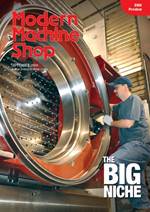Ensuring The Safety Of Inexperienced Employees
Shop safety should never be overlooked. It’s especially important to reinforce awareness of and respect for potentially dangerous surroundings to employees who are new to the machine shop environment.
Photographing the big horizontal boring mills found in this story reminded me of the time I had a (literal) run-in with a boring mill when touring a different shop years ago. While crouching down and positioning myself to get a good photo of an operating mill, I unknowingly entered the work area of another one. Soon after, that other mill’s table began pushing me like a slow-moving elephant. Luckily, I wasn’t knocked down and was able to easily, albeit embarrassingly, step away. I recall muttering under my breath, “That was stupid, Derek” as I moved back to where I should have been standing in the first place.
There was no floor tape or safety chain outlining a safe perimeter around the big machine. That said, I certainly should have paid more attention to my surroundings, especially considering how much time I had spent in shops and manufacturing facilities prior to this particular visit.
Unlike me in this one lapse, your shop veterans likely have a good handle on safe shop procedures and a firm understanding of just how dangerous their workplace can be. They realize the potential for injury looms large. However, an increasing number of shops are hiring shopfloor employees who have no machining background and possibly no experience working in any type of manufacturing environment. In such cases, shops must be even more diligent in educating their new employees about appropriate shop practices as well as observing those employees as they perform their duties. Of course shops should also continuously identify and eliminate safety hazards hidden throughout the shop.
When it comes to new employees, get back to the basics. Are they conscientious about wearing their safety glasses day in and day out? Do they come to work with the proper clothing and footwear? Do they manage their hair in a suitable manner for this work? Have they studied your shop’s safety manual? Have you provided sufficient training about safe shop practices?
As for your facility, is safety signage clearly visible throughout the shop? Are aisles clear of debris? Are your machines leaking fluid onto the floor? Have any of the machine enclosure interlocks been disabled? Is a proper lockout/tagout procedure in place? Do you stick to a formal preventive maintenance program?
Obviously a safe work environment not only reduces the risk of worker injury, but also makes a shop more inviting to potential bright prospects who may have never stepped foot in such operations. Given the current dearth of skilled labor, shops will likely need to draw from such an inexperienced lot more often than not.











.jpg;maxWidth=300;quality=90)

